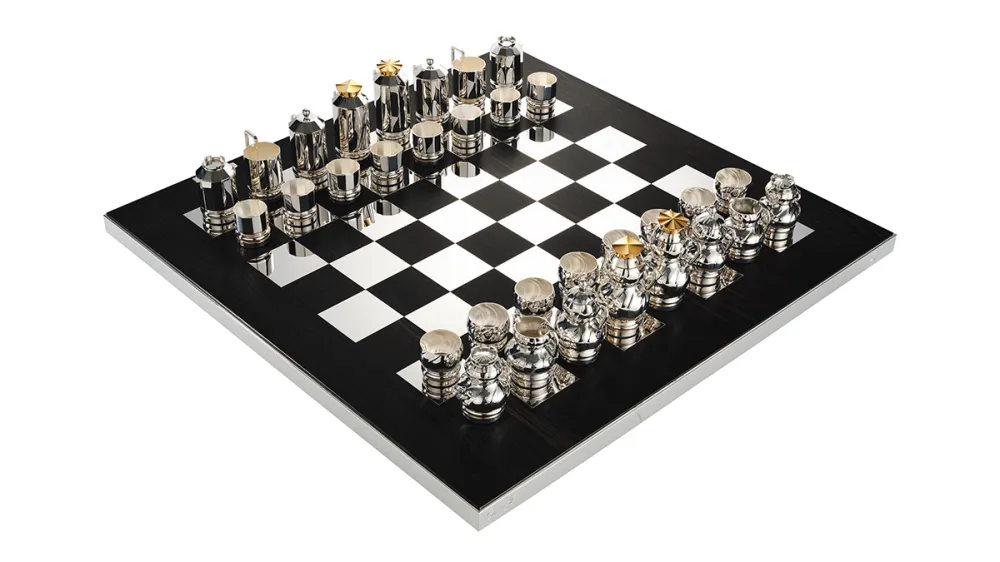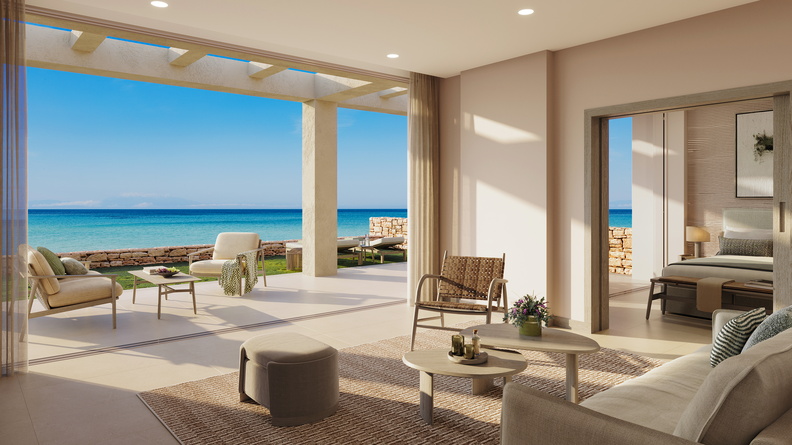The Parisian silversmith’s famous Art Deco and Art Nouveau tea services square off in this exquisite limited-edition chess set.
Christofle and its subsidiaries have used a variety of hallmarks, from a rooster to a cat’s head, since the Parisian firm was founded in 1830. It employs the knight, one of the most powerful pieces on the chessboard, on the high-quality items it has silver-plated. In a winking nod to that heritage, the company has launched its first game, a chess set called Duel des Thés.
“We were thinking about how games are booming and what would be Christofle’s interpretation,” Marie Beaussier, the brand’s director of product design, tells Robb Report. “The idea was to have two iconic tea services, Art Nouveau and Art Deco, actually compete.” The resulting set, whose name translates to “duel of teas”, is a playful spin that replaces key pieces with teapots, creamers, cups and sugar bowls.
Thomas Jean, Christofle’s director of product development, notes that the method is the same for creating a standard tea service, “but the miniaturisation of all the pieces makes each step immensely challenging because if it’s not done well, the silversmith will have to start over”. Instead of relying on machine manufacturing, artisans make each component—plus all the moulds and other tools used to produce them—by hand at the brand’s factory in Normandy.

“The pieces are quite small, from two to seven centimeters, so it adds another level of complexity to the project,” Beaussier says. The 32 chessmen, tiny as they may be, are also fully functional: the mini teapots come complete with hollowed-out spouts and hinged lids and are as detailed as their life-size counterparts. The boards are assembled by Jean-Brieuc Chevalier, a cabinetmaker from Angers, who inlays pin oak with reflective sterling-silver squares.
The sets, which require six months to produce, are priced at around €230,000, and Christofle will make only eight examples. You can see the first edition at Christofle’s store in Harrods, in London, but you can place an order through any of its boutiques. Luckily, winning the set won’t require as much strategy as winning the game itself. “Chess is a lot like silversmithing,” says Beaussier. “It’s demanding, and it takes a long time to become good.”
1. Drawing Mock-Ups
One side of chess pieces is based on an 1891 Art Nouveau design called Courges, the other on the Art Deco Printania service from 1924. To re-create them on a smaller scale, Christofle’s Haute Orfèvrerie (or high goldsmithing) team hand-draws mock-ups to determine what needs to change as the tea sets get shrunk. “There had to be some modifications in terms of proportion and also so that the player understands which piece is what,” Beaussier explains.

2. Hand-Spun Sheets
Creating a chessman begins with producing the base via hand-spinning sheets of sterling silver with a mandrel, a special boxwood tool that gives the piece its shape. The process involves rotating the metal on a lathe while the silversmith applies pressure with a spoon against the mandrel. A felt pad is then glued to the base so it can glide smoothly across the board.

3. Mandrel Shaping
To form the bodies, craftsmen again use mandrels. For the Printania side, a sheet of sterling is folded around a mandrel that bears the same vertical lines of the final piece. To echo the Courges service’s curves, a craftsman arranges 12 miniature stakes in numbered order inside the mandrel, then spins the sheet of silver around it, ensuring the body stays hollow and round.

4. Silversmith Decorating
The pieces are mounted on a pitch, where a silversmith gently hammers the metal to create fine lines and other intricate motifs. Unlike engraving, for which material is removed to make deep marks, the silversmith pushes and pulls the metal to add decorations.

5. Soldering
The base, handle, or spout is soldered to the main body of each piece, which requires expertise with a gas torch. “On a real teapot, the thickness of the metal is about 1.2 or 1.5 millimeters,” Jean says. “Here, the sheets of metal are only 0.8 millimeters, so you have to be careful not to melt it.”

6. Electroplate and Polish
Once assembled, each piece is electroplated with a thin layer of silver—a technique that the company’s founder, Charles Christofle, introduced to France in 1842. “We add a final coat of silver to mask the soldering and make the pieces look more uniform,” explains Jean. The kings and queens—teapots, in this case—are adorned with 24-karat-gold-plated silver crowns. A final polish, called brightening, results in the firm’s signature mirror finish.

7. Board Making
The board is made from pin oak, a rare species of fossilized wood. The material gets its charcoal hue from having been buried and preserved in peat bogs for up to 5,000 years. “The board is oiled, not varnished, so we can appreciate the nuances of the wood,” Beaussier says.

8. Alternating Squares
A laser-cutting machine is used to mark spaces for the alternating squares, which are carved out by hand, allowing the sterling-silver tiles to sit flush with the wood. Once glued into place, they’re given a final polish. “We put rhodium plating on the [tiles] because silver can tarnish,” Jean says. “Also, rhodium is very hard. It’s the same color as sterling silver, but it’s not as fragile and won’t scratch.”

9. Belt Fastening
A sterling-silver belt is fastened to the side of the board and inscribed with quality and authenticity hallmarks, including the year of production, edition number, and the head of Minerva, a French government symbol signifying the silver is of at least 92.5 percent purity.

10. Completion
To fend off fingerprints and maintain the silver’s luster, each set comes with gloves and a polishing cloth (and a certificate of origin). The board and pieces are housed in a black carrying case made of a wood-fiber material called Valchromat that has been covered in an antioxidant fabric to prevent discoloration.








